
Alstroemeria, commonly called the Peruvian lily or lily of the Incas, is a genus of flowering plants in the family Alstroemeriaceae. They are all native to South America, although some have become naturalized in the United States, Mexico, Australia, New Zealand, Madeira and the Canary Islands. Almost all of the species are restricted to one of two distinct centers of diversity: one in central Chile, the other in eastern Brazil. Species of Alstroemeria from Chile are winter-growing plants, while those of Brazil are summer growing. All are long-lived perennials except A. graminea, a diminutive annual from the Atacama Desert of Chile.

Aeonium, the tree houseleeks, is a genus of about 35 species of succulent, subtropical plants of the family Crassulaceae. Many species are popular in horticulture. The genus name comes from the ancient Greek αἰώνιος / aiōnios (ageless). While most of them are native to the Canary Islands, some are found in Madeira, Cape Verde, Morocco, in East Africa and Yemen.

Lithops is a genus of succulent plants in the ice plant family, Aizoaceae. Members of the genus are native to southern Africa. They avoid being eaten by herbivores with their camouflage as small stones, and are often known as pebble plants or living stones.

Frithia pulchra, the fairy elephant's feet, is a species of flowering plant in the fig‑marigold family Aizoaceae, endemic to Gauteng Province, South Africa. Its natural habitat is temperate grassland with high summer rainfall. A tiny stemless succulent growing to just 10 cm (3.9 in) tall and 20 cm (7.9 in) broad, it has bulbous oblong leaves with leaf windows at the tip; and magenta and white daisy-like flowers in winter. During periods of drought it has the ability to shrink beneath the soil surface, thus avoiding excessive desiccation, but making it extremely difficult to find.

Oscularia deltoides, the deltoid-leaved dewplant, dassievygie or sandsteenvygie is a species of flowering succulent plant in the fig-marigold family Aizoaceae that is native to the south-western Cape, South Africa.
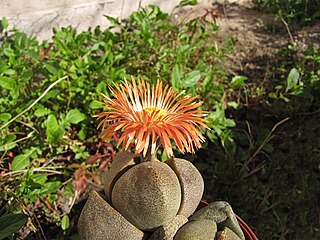
Pleiospilos nelii, the split rock, splitrock or living granite, is a species of flowering plant in the family Aizoaceae, native to South Africa. It grows in semi-arid areas with rainfall of between 150mm and 300mm, in the Karoo of South Africa.

Pleiospilos bolusii, the mimicry plant, is a species of flowering plant in the family Aizoaceae, native to the Eastern Cape province of South Africa, where it grows at an elevation of 750–1,100 m (2,461–3,609 ft). The species epithet bolusii honours Harry Bolus, a 19th-century South African botanist.
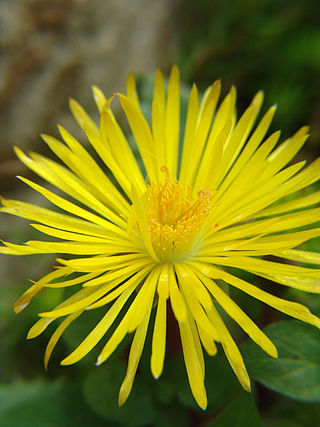
Carruanthus is a very small genus of only two species of flowering plants belonging to the ice plant family Aizoaceae.
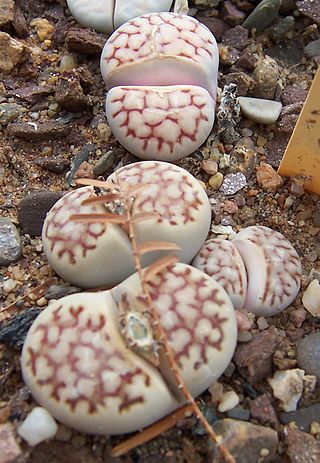
Lithops karasmontana, is a species of flowering plant in the ice plant family Aizoaceae, native to Namibia and South Africa.
Carruanthus peersii is from the Carruanthus genus of flowering plants from the ice plant family Aizoaceae.
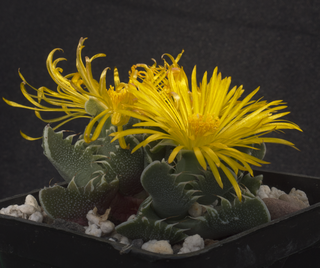
Faucaria tigrina, tiger jaws, is a species of succulent plant in the family Aizoaceae. It is endemic to the southern Cape Provinces of South Africa around Makhanda, and also cultivated as an ornamental. It has fleshy triangular leaves, a clumping habit, and blooms in autumn with yellow daisy-like flowers.

Conophytum flavum, the yellow cone plant, is a small South African species of succulent flowering plant of the family Aizoaceae.

Orbea variegata is a species of flowering plant in the family Apocynaceae, known as the star flower. It is native to the coastal belt of the Western Cape, South Africa, growing actively during the winter rainfall season. It is an invasive species in southern Australia.

Lithops olivacea is a species of the genus Lithops under the family Aizoaceae. The name olivacea refers to the Latin word for olive (oliva) combined with the suffix -cea, meaning "of the likeness", producing the idea of "olive likeness". Lithops olivacea grow primarily in the Bushmanland of South Africa. They grow most abundantly in the regions of Aggeneys, Pofadder, and Namies. L. olivacea also received the Royal Horticultural Society's Award of Garden Merit for being "excellent for ordinary use in appropriate conditions, available to buy, of good constitution, essentially stable in form & colour, [and] reasonably resistant to pests & diseases."
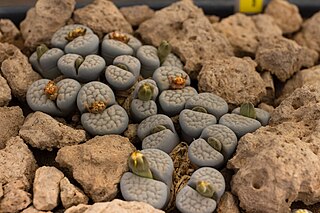
Lithops schwantesii is a succulent plant of the genus Lithops and a member of the family Aizoaceae. L. schwantesii receives its name from Gustav Schwantes, a prominent archaeologist and botanist of late 19th and 20th century. The succulent also received the Royal Horticultural Society's Award of Garden Merit for being a resilient and easy to cultivate plant.
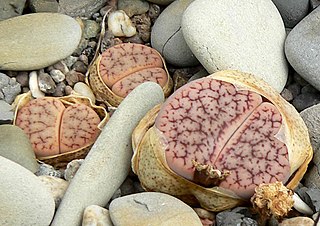
Lithops pseudotruncatella is a species of succulent in the family Aizoaceae. Initial confusion associated with Conophytum truncatum is where it derives its name, literally meaning "fake-truncatum". It also received The Royal Horticultural Society's Award of Garden Merit. The plant is endemic to Namibia.

Trichodiadema densum is a succulent flowering plant in the fig-marigold family Aizoaceae, native to the Willowmore region of the Western Cape Province, South Africa.

Conophytum obcordellum is a species of flowering plant in the family Aizoaceae, native to the Western Cape of South Africa. It is a small clump-forming succulent, growing to 10 cm tall and 1 m broad, forming glossy grey pebble-shaped growths, heavily marked with dots and lines. Daisy-like, silky white or pink night-scented flowers are borne on mature plants in spring.

Malotigena is a genus of flowering plants in the ice plant family Aizoaceae. It has only one currently accepted species, Malotigena frantiskae-niederlovae, native to Lesotho. Growing up to 50 cm (20 in) broad and only 3 cm (1.2 in) high, it is a mat-forming evergreen succulent with brilliant yellow daisy-like flowers in summer. The foliage turns red in autumn.
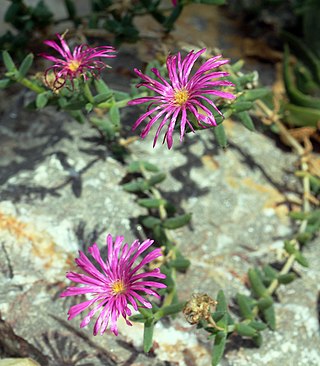
Trichodiadema barbatum is succulent plant of the genus Trichodiadema, native to the Eastern Cape Province, South Africa.





















